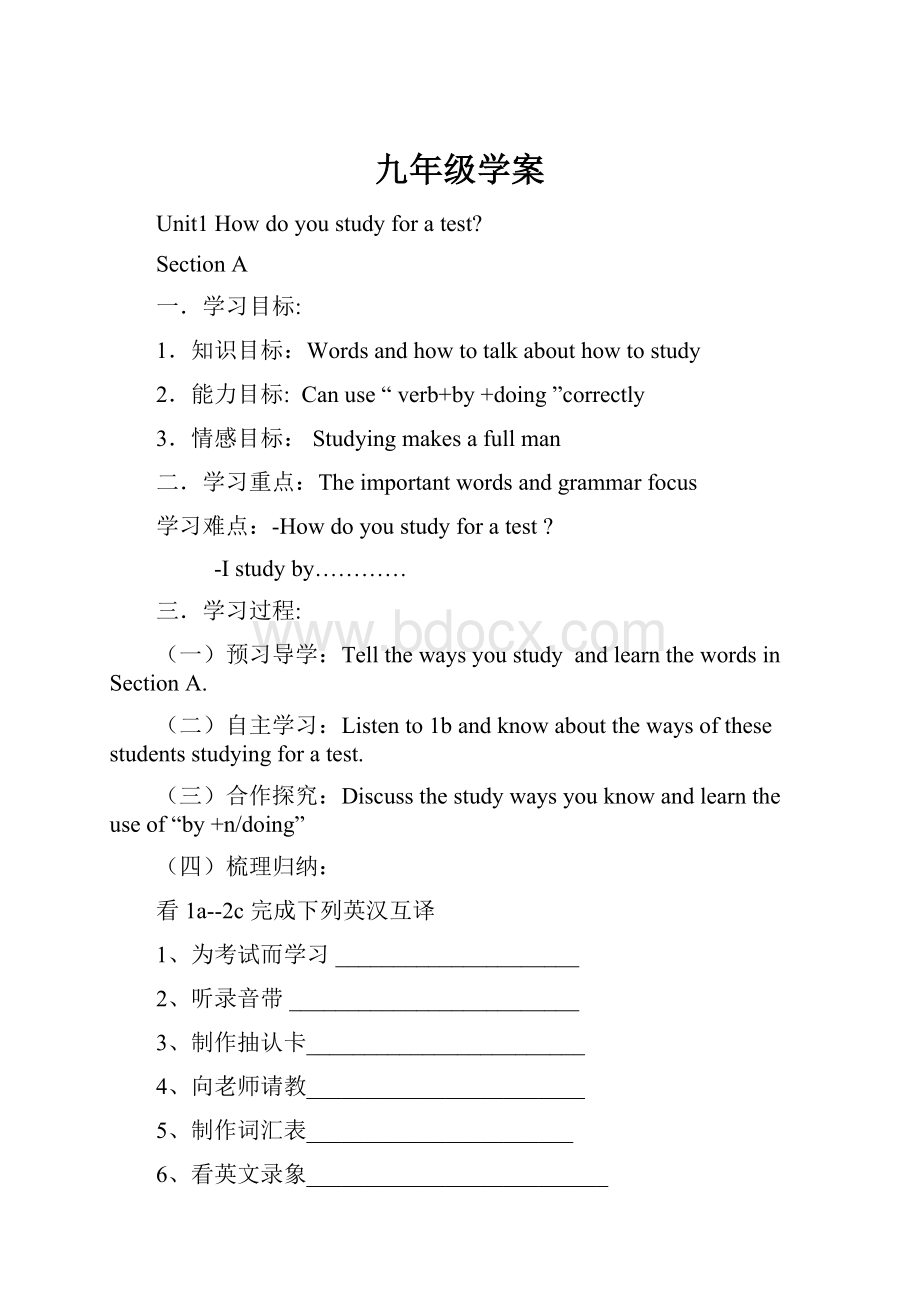九年级学案.docx
《九年级学案.docx》由会员分享,可在线阅读,更多相关《九年级学案.docx(110页珍藏版)》请在冰豆网上搜索。

九年级学案
Unit1Howdoyoustudyforatest?
SectionA
一.学习目标:
1.知识目标:
Wordsandhowtotalkabouthowtostudy
2.能力目标:
Canuse“verb+by+doing”correctly
3.情感目标:
Studyingmakesafullman
二.学习重点:
Theimportantwordsandgrammarfocus
学习难点:
-Howdoyoustudyforatest?
-Istudyby…………
三.学习过程:
(一)预习导学:
Tellthewaysyoustudy andlearnthewordsinSectionA.
(二)自主学习:
Listento1bandknowaboutthewaysofthesestudentsstudyingforatest.
(三)合作探究:
Discussthestudywaysyouknowandlearntheuseof“by+n/doing”
(四)梳理归纳:
看1a--2c完成下列英汉互译
1、为考试而学习_____________________
2、听录音带_________________________
3、制作抽认卡________________________
4、向老师请教________________________
5、制作词汇表_______________________
6、看英文录象__________________________
7、和朋友练习对话___________________
8、大声朗读练习发音____________________
9、learnalotthatway______________________
10.improvemyspeakingskills___________
11.toohardtounderstandthevoices_________
四.典题赏析:
例1、Istudyforatestbyworkingwithfriends 我通过和朋友一起学习来准备考试"by+n\doing\pron(代词)表示通过手段、方式或方法做…可以用来回答how引导的特殊疑问句。
by的用法大致有一下几种:
(1)、表位置:
“在……旁边;靠近……”Hesitsbythewindow. (他坐在窗户旁边)
(2)、表时间“到……为止,不迟于……”Hewillcomebackbynoon.(他中午之前就回来)
(3)、表“乘……,通过……”Hegoestoschoolbysubway.
(4)、与反身代词连用表示“单独,独自”
Icansolvetheproblembymyself.(我能独立解出这道难题)
(5)用于被动结构“由,被”Theenvironmentisdestroyedbypollution.(环境被污染破坏)
例2、It'stoohardtounderstandthevoices.
1.此句有一句型It's+adj.+(forsb.)+todosth.
Eg:
______________________________________________________
2.短语too…to意为"____________________"结构为too+adj.+todosth可用not…enoughtodo和so…that句式改写
Eg:
他太小了,不能自己穿衣服。
(用三种句型翻译)
_____________________________________________________________________________________________________________________________________________________________________
例3、Whataboutreadingaloudtopracticepronunciation?
1.此句中Whatabout后跟__________________ __________
what可用________来代替。
2.aloud为adv.意为“出声地”指使人听见而发音,常与read连用,强调从不出声到出声,别人能听得见,但声音不一定很大,无比较级和最高级。
loud强调声音响亮,常与spead,talk,sing,laugh连用,有adj.和adv的特点常用比较级。
Loudlyadv.“大声地,喧闹地”声音不悦耳,有时可用loud互换。
Eg:
ReaAnswers:
readthetextaloud. 朗读课文.
Trytosinglouder 试着大声读.
Whoisknockingatthedoorloudly?
谁在使劲敲门
五.中考链接
用所给词的适当形式填空
1.Whatabout__________(keep)anEnglishnotebook?
2.TheyhopetojoinanEnglishlanguageclubtopractice___________(speak)English.
3.Ifindit_________(frustrate)thatIcan'tspeakEnglishwell.
4.Ican'tunderstand__________(speak)English.
5.Therearemany__________(differently)betweenEnglishnamesandChinesenames
六.能力提升:
句型变化.
1.Ilearnbywatchingthelecturevideo. (对划线部分提问)
___________________youlearn?
2.HelearnsEnglishbywatchingforeignDVDs.(改为一般疑问句并做肯定 回答)
__________he____________EnglishbywatchingforeignDVDs?
__________,he________.
3.GrammarissoboringthatIcan'tstudyit.(改为同意句)
Grammaris________boringforme_________study.
4.Heknowshowtospelltheword.(改为否定句)
He_______________howtospelltheword.
5.Whydon'tyoujoinanEnglishlanguageclub?
(改为同意句)
Why__________________anEnglishlanguageclub?
Unit1Howdoyoustudyforatest
SectionB
一、学习目标:
1、知识目标:
掌握下列单词或短语
pronounce,bymistake,mistake……for……,challenge,get……..right,solution,maybe/maybe,realize,beafraidtodosth/beafraidofdoingsth/beafraid+that
2、能力目标:
能够完成关于Ways的话题讨论
3、情感目标:
在谈论Ways的话题中明白科学的学习方法的重要性
二、学习重点:
听力和分角色表演对话中的重点单词和短语
学习难点:
写一篇关于你在学习外语的过程中最有效的方法的文章
三、学习过程:
(一)预习导学:
复习有关学习方法并继续研究和学习更科学的学习方法
(二)自主学习:
认真准备听力并熟读3band3c
(三)合作探究:
Pairworkandtrytointerviewtheclassmates
(四)梳理归纳:
翻译下列短语
1.英语口语______________ 2、犯错误___________________
3、首先___________ 4、嘲笑某人______________________
5、一个完整的句子____________
6、做某事有困难______________
四.典题赏析:
Whydon’tyoujoinanEnglishlanguageclubtopracticespeakingEnglish?
你为何不加入英语俱乐部训练口语呢?
句型:
Whydon’tyou+动词原形?
为什么不………..?
本句型形式上是否定的,实际上是建议对方做某事。
其常用形式也可以是
Whynot+动词原形?
所以本句也可以换成WhynotjoinanEnglishlanguageclub……..?
另外,在实际运用过程中可以用更简单的说法Whynot?
Eg:
让我们去踢足球,好吗?
--Let’sgotoplayfootball,shallwe?
--Whynot?
为什么不呢?
五.中考链接
完成对话:
A:
Howdoyoustudy_______ ________(考试).
B:
Ioften_________ (上课记笔记,下课练习讲口语)
A:
______ ____(为什么不)watchEnglishCD?
B:
Iwatchit_______________________________.(一周几次).
A:
Doyoulike________ ________(听英语歌吗)?
B:
No,Idon’t.
Butmysister______me it.(想要我听).
A:
Howoftendoesshelistentoit?
B:
Shedoessoeveryday,becauseshesaysit’s___________________(对她的英语有益)
A:
Ithinkso.You’dbetterdoit.
B:
I’lltry.Thankyou.
六.能力提升:
1.---Howdoyoustudy____atest?
---Istudy____working___agroup.
A. for;in;with B.for; by;at C.for;by;withD.of; in;by
2---Doyouthinkit’sgoingtorain?
---I_______not!
A. wish B. thinks C.hope D.hopeit
3.Theboyusedtospendtime______hisclassmates.
A. chat with B.chattingwith C.tochatwith D.on chattingwith
4.Aseriousaccident______herandshewasbadlyhurt.
A. happenedto B.washappenedto
C. washappening D.tohappened
5.Youmustworkharderthisterm,_______you?
A. needn’t B.mustn’t C. don’t D.aren’t
6.We hadfun______applesonthefarmwiththefarmers.
A.to pick B. picked C. pick D.picking
7.Whatwouldyoudoifyou______awallet?
A. find B. finding C. found D.have found
8.Youcanchoose ofthesetwostorybooks.Theyare____ interestingenough,Ithink..
A.either, both B. neither, both
C.both, all D.none,all
9. Ididn’tleave hecameback.
A because B after C when D until
Unit2 Iusedtobeafraidofthedark
SectionA
一.学习目标:
1.知识目标:
Talkaboutwhatyouusedtobelikeandthenewwords.
2.能力目标:
反意疑问句的正确运用
3.情感目标:
只有向后看才能理解生活;但要生活好,则必须向前看。
二.学习重点:
usedtodo 过去常常做某事
usedtobe+adj.过去常常是…
beusedtodoing习惯于做某事
beusedtodo/fordoing被用来干某事
学习难点:
Talkaboutthepast
三.学习过程:
(一)预习导学:
Talkaboutyourpastandlearn1a,thenfillinthechart.
(二)自主学习:
listento1b,2aand2b.
(三)合作探究:
Lookatthepictureandmakeconversations(1c),Talkaboutwhatarethethingsthatyouusedtobeafraidofandyouarestillafraidofwithyourpartner(2c/3a/3b)
(四)梳理归纳:
1.usedtodosth表示“过去常常干某事”表示过去经常发生的动作,暗含与现在的对比。
Eg:
Didyouusetogotoschoolonfoot
你过去常常步行去上学吗?
be/getusedtosth./doingsth表示“习惯于某事/做某事”,其中used是形容词,to是介词,后跟名词或动名词。
Eg:
I’musedtotakingawalkaftersupper
我习惯于晚饭后散步。
beusedtodosth表示“被用来干某事”是动词use的被动语态。
beusedtodosth.=beusedfordoingsth
Eg:
Theglassesofthiskindareusedtoprptectyoureyes.
这种眼镜用于保护眼睛。
2.beinterestedinsth/doingsth.对做……感兴趣=take/have/showaninterestinsth/doingsth.
3.beontheswimteam加入游泳俱乐部(是俱乐部的一员) beintheswimteam加入游泳俱乐部
4.beafraidofsth./doingsth害怕某事/作某事=beterrifiedofsth./doingsth=beafraidtodosth=beterrifiedtodosth
四.典题赏析:
反意疑问句表示说话人对所陈述的事情有所怀疑或不肯定,想通过对方的回答来加以肯定或否定。
反意疑问句由两部分构成:
对事物的陈述+(助动词/系动词/情态动词+主语)简短的提问。
反意疑问句构成有两种。
第一种结构是:
肯定的陈述句+逗号+一般疑问句的简略否定+问号。
对于反意疑问句的肯定回答与一般疑问句的回答方式一样。
例:
-Theyborrowedsomemoneyfromyou,didn’tthey?
-Yes,theydid./No,theydidn’t.
第二种结构是:
否定的陈述句+逗号+一般疑问句的简略肯定+问号。
这种情况与中文的表达习惯很不一样。
例:
-Therewasn’tafootballgameonTvlastnight,wasthere?
-Yes,therewas./No,therewasn’t.
五.中考链接:
1.I’mdifferentfrommytwinsister.Ilovedancing, sheisinterestedinreading.
A.so B.or C.but D.and
2.Smokingisbadforyourhealth.You’dbetter
A.giveupit B.giveitup C.takeoutit D.takeitout
3.--Howmuchdidyou forthedictionary?
--$12.
A.buy B.spend C.cost D.pay
4.Youmustn’tgive foreignlanguageforevenaday.
A.uptostudy B.upstudying C.intostudy D.instudying
5.Youdidn’tusetoliveinBeijing, ?
A.didn’tyou B.didyou C.weren’tyou D. wereyou
六.能力提升:
翻译下列句子
根据句意和首字母提示完成单词
1.Timeisveryimportanttous.Pleasedon’tw time.
2.Thesethingsarerathercheap.Anyonecana ourprices.
3.MissZhangisagoodteacher.Sheisp withherstudents.
4.Pleasepaya towhatI’msaying.
5.Theyarei incollectingstamps.
6.Hewast ofthedogwhenhewasyoung
Unit2 Iusedtobeafraidofthedark
SectionB
一.学习目标:
1.知识目标:
listeningandwritingaboutwhatsbusedtobelikeandthenewwords
2.能力目标:
Canwriteanarticle“HowI’ve/hehas /shehas changed”byyourself
3.情感目标:
前车之鉴,后事之师。
二.学习重点:
文中出现的重点短语及带有否定词的反意疑问句的用法。
学习难点:
Talkaboutthepast andimproveyourreadingskills.
三.学习过程:
(一)预习导学:
Talkaboutyourpast。
(二)自主学习:
listentothetapecarefullyandreadthetextbyyourselves.
(三)合作探究:
Pairwork:
Thinkofthingsyouusedtodonow.thenlistalltheinformationaboutyourgroup.
(四)梳理归纳:
1.Afford意为“支付的起(时间,金钱等),担负的起”,前面常与can或beableto连用,后面加sth或todosth.
Eg:
他能买的起着座房子。
他母亲支付不起他孩子的教育费用。
Pay为 过去式paid 用法sbpay钱forsth可用sbspend钱onsth/sbspend钱doingsth或sthcostsb钱替换。
Eg:
我们给女儿买不起那架钢琴。
2.sbspendtime(in)doingsth花费时间做某事
Ittakessbsometimetodosth花费某人时间去作某事
Sb.pay moneyforsth.某人买某物花了…钱
Sth+cost+sb+money/time某物花费某人…钱/时间
3.inthepastfewyears=inthelastfewyears=theseyears=overtheyears“这几年来”,常与现在完成时连用。
4.某人/某物好象,似乎…
(1)Itseemsthat+句子
(2)Sb./Sth.seemstodo/ (3)Sb./Sth.see